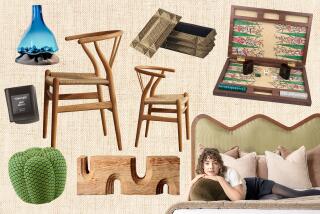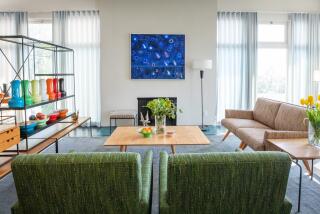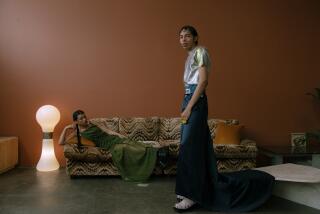London’s show of shows
- Share via
London — The red double-decker bus wasn’t going anywhere, but that didn’t stop the crowds from climbing aboard, poking around, admiring the seats, then jumping off. The bus, parked inside a London convention center during a contemporary furnishings show, was loaded with a new line of living room, kitchen and bath products sporting graphics familiar to anyone who has ridden public transportation here.
The All Zones line was one of 450 exhibitors selected for 100% Design, a four-day international show that ended Saturday and focused on interior products -- from floors to walls to ceilings, and everything in between. Many of the furnishings debuted at 100% Design.
“The show is known for being experimental and innovative, and it’s hard to get into,” says Deirdre Dyson, a modern rug designer with a showroom in Kings Row, London (www.deirdredyson.com) and the wife of James Dyson, the bagless vacuum-cleaner inventor.
Despite her connections, Deirdre Dyson applied twice to the show before being accepted last year by a panel of industry experts, including a curator of London’s Victoria & Albert Museum. Half of the applicants are turned down. Those who get exhibition space, as varied as name-brand companies and recent design school grads experiencing their first big break, have a chance to attract the attention of 36,000 interior designers, architects, manufacturers and design-savvy homeowners.
Venerable American furniture company Herman Miller displayed its collection of designer chairs and tables for the home and office (www.herman miller.com). Well-known British designer Tom Dixon showed his Fresh Fat line of squiggly, glasslike easy chairs and bowls made from clear plastic that look as if they have been squirted out of a toothpaste tube. The malleable strips of polymer are looped by hand like chain links and melded together when cooled
(www.tom dixon.net).
Lefroy Brooks, one of Britain’s leading makers of bathroom fixtures, launched its cartoony Bel Air line, which was inspired by 1950s Chevrolet hood ornaments and tailfins. Faucets are shaped like chubby jets and ceramic pedestal sinks have chrome legs and bands (www.lefroybrooks.com).
Inside the Routemaster double-decker, the London Transport Museum kicked off its retro-inspired All Zones line of bar stools, pillows and lampshades wrapped in the same upholstery pattern used on bus and subway seats. Rectangular patches of red, orange, brown and tan are printed on cotton fabric as well. There are also ceramic espresso sets, clocks and tiles painted with the London Underground logo -- a thick red circle with a blue bar intersecting it -- and the black dumbbell-shaped interchange map symbol.
Sharing convention space with established names were progressive first-timers. Marion Mainstone has spent 14 years since graduating from the Royal College of Art obsessing about the folding chair. Her model, the flipit, opens and shuts with one hand, closes to half the height of a typical folding chair and stands upright when stored. Her company, the Folding Co. of London (www.foldingcompany.co.uk), is working on an aluminum-framed version that she says will update the way we think about chairs.
Another new company, What They Did Next of Sussex, England, unveiled cubey plastic Glow tables with votives embedded into tabletops and arranged in circles or curves, complete with matching cotton fabrics (www.whattheydidnext.com).
Designer Helen Amy Murray of London is patenting her process of hand-cutting foam-backed suede and leather to form three-dimensional fabrics used on chairs, sofas and wall art (www.helenamymurray.com).
Pureform of West Midlands, England, designs, develops and manufactures furniture reduced to its essential parts. The company presented a simple three-legged stool inspired by a paper snowflake, and a slim Jacob lounge chair with a straight back that imitates a church pew (www.pureformdesign.co.uk).
Wall coverings on display used age-old materials and cutting-edge computer processing. Companies showed wall surfaces made of cork, grass and wood chips, and wallpaper in lime-colored barbed wire and nature-inspired digital designs.
More to Read
Sign up for The Wild
We’ll help you find the best places to hike, bike and run, as well as the perfect silent spots for meditation and yoga.
You may occasionally receive promotional content from the Los Angeles Times.






